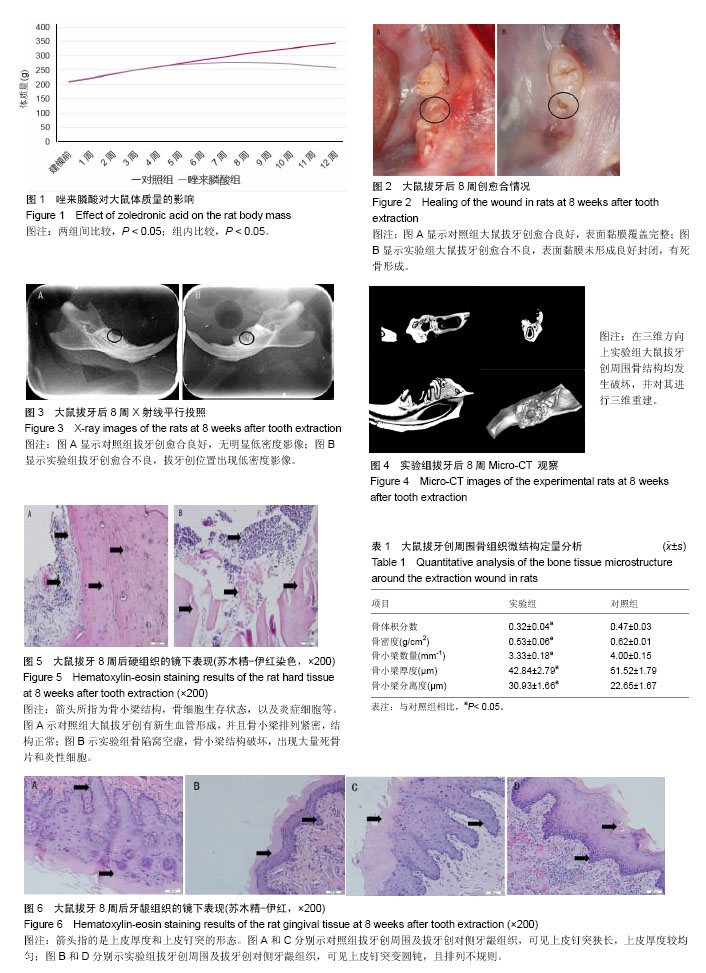| [1] Ruggiero SL, Dodson TB, Fantasia J, et al. American Association of Oral and Maxillofacial Surgeons position paper on medication-related osteonecrosis of the jaw--2014 update. J Oral Maxillofac Surg.2014;72(10):1938-1956.[2] Zandi M, Dehghan A, Malekzadeh H, et al. Introducing a protocol to create bisphosphonate-related osteonecrosis of the jaw in rat animal model. J Craniomaxillofac Surg.2016; 44(3):271-278.[3] Sharma D, Hamlet S, Petcu E, et al. Animal models for bisphosphonate-related osteonecrosis of the jaws - an appraisal. Oral Diseases.2013;19(8):747-754.[4] Allen MR, Chu TG, Ruggiero SL. Absence of Exposed Bone Following Dental Extraction in Beagle Dogs Treated With 9 Months of High-Dose Zoledronic Acid Combined With Dexamethasone. J Oral Maxillofac Surg. 2013;71(6):1017-1026.[5] Allen MR, Kubek DJ, Burr DB, et al. Compromised osseous healing of dental extraction sites in zoledronic acid-treated dogs. Osteoporosis International.2011;22(2):693-702.[6] Burr DB, Liu Z, Allen MR. Duration-dependent effects of clinically relevant oral alendronate doses on cortical bone toughness in beagle dogs. Bone.2015;71:58-62.[7] Pautke C, Kreutzer K, Weitz J, et al. Bisphosphonate related osteonecrosis of the jaw: A minipig large animal model. Bone. 2012;51(3):592-599.[8] López-Jornet P, Camacho-Alonso F, Molina-Miñano F, et al. An experimental study of bisphosphonate-induced jaws osteonecrosis in Sprague-Dawley rats. J Oral Pathol Med. 2010;39(9):697-702. [9] Su J, Feng M, Han W, et al. The effects of bisphosphonate on the remodeling of different irregular bones in mice. J Oral Pathol Med. 2015;44(8):638-648.[10] Li CL, Lu WW, Seneviratne CJ, et al. Role of periodontal disease in bisphosphonate-related osteonecrosis of the jaws in ovariectomized rats. Clin Oral Implants Res.2016;27(1): 1-6.[11] Agacayak KS, Yuksel H, Atilgan S, et al. Experimental investigation of relationship between trauma and bisphosphonate-related osteonecrosis. Niger J Clin Pract. 2014;17(5):559-564.[12] Jabbour Z, Do NC, El-Hakim M, et al. Bacterial profile and bone healing in rats receiving cancer therapeutic doses of bisphosphonates and corticosteroids: a pilot study. Int J Oral Maxillofac Surg.2016;45(9):1162-1169.[13] Marx RE. A decade of bisphosphonate bone complications: what it has taught us about bone physiology. Int J Oral Maxillofac Implants.2014;29(2):e247-e258.[14] Lin JH, Chen IW, Duggan DE. Effects of dose, sex, and age on the disposition of alendronate, a potent antiosteolytic bisphosphonate, in rats. Drug Metab Dispos.1992;20(4): 473-478.[15] Takaoka K, Yamamura M, Nishioka T, et al.Establishment of an Animal Model of Bisphosphonate-Related Osteonecrosis of the Jaws in Spontaneously Diabetic Torii Rats.PLOS ONE. 2015;10(12):e144355.[16] Kim JW, Tatad JC, Landayan ME et al. Animal model for medication-related osteonecrosis of the jaw with precedent metabolic bone disease. Bone.2015;81:442-448.[17] Silva P G D B, Ferreira Junior A E C, Teófilo C R, et al. Effect of different doses of zoledronic acid in establishing of bisphosphonate-related osteonecrosis. Archives of Oral Biology. 2015;60(9):1237-1245.[18] Dieterle F, Schlotterbeck G, Binder M, et al. Application of Metabonomics in a Comparative Profiling Study Reveals N-Acetylfelinine Excretion as a Biomarker for Inhibition of the Farnesyl Pathway by Bisphosphonates. Chem Res Toxicol. 2007;20(9):1291-1299.[19] Pfister T, Atzpodien E, Bohrmann B, et al. Acute renal effects of intravenous bisphosphonates in the rat. Basic Clin Pharmacol Toxicol.2005;97(6):374-381.[20] Donetti E, Gualerzi A, Sardella A, et al. Alendronate impairs epithelial adhesion, differentiation and proliferation in human oral mucosa. Oral Diseases. 2014;20(5):466-472.[21] Ravosa M J, Ning J, Liu Y, et al. Bisphosphonate effects on the behaviour of oral epithelial cells and oral fibroblasts. Archives of Oral Biology. 2011;56(5):491-498.[22] Walter C, Klein M O, Pabst A, et al. Influence of bisphosphonates on endothelial cells, fibroblasts, and osteogenic cells. Clinical Oral Investigations.2010;14(1): 35-41.[23] Zafar S, Coates DE, Cullinan MP, et al. Zoledronic acid and geranylgeraniol regulate cellular behaviour and angiogenic gene expression in human gingival fibroblasts. J Oral Pathol Med. 2014;43(9):711-721.[24] Keskinruzgar A, Bozdag Z, Aras MH, et al. Histopathological Effects of Teriparatide in Medication-Related Osteonecrosis of the Jaw: An Animal Study. J Oral Maxillofac Surg. 2016;74(1): 68-78.[25] Lang M, Zhou Z, Shi L, et al. Influence of zoledronic acid on proliferation, migration, and apoptosis of vascular endothelial cells. Br J Oral Maxillofac Surg. 2016;54(8):889-893[26] Verron E, Bouler JM. Is bisphosphonate therapy compromised by the emergence of adverse bone disorders?. Drug Discovery Today.2014;19(3):312-319.[27] 付庆彪,崔彩雯,轩宾,等. 唑来膦酸对牙龈成纤维细胞增殖及凋亡的影响[J]. 中华口腔医学杂志, 2015(11):667-670.[28] Otto S, Pautke C, Opelz C, et al. Osteonecrosis of the Jaw: Effect of Bisphosphonate Type, Local Concentration, and Acidic Milieu on the Pathomechanism. J Oral Maxillofac Surg. 2010;68(11):2837-2845.[29] Otto S, Hafner S, Mast G, et al. Bisphosphonate-Related Osteonecrosis of the Jaw: Is pH the Missing Part in the Pathogenesis Puzzle?. J Oral Maxillofac Surg. 2010;68(5): 1158-.1161.[30] Otto S, Schreyer C, Hafner S, et al. Bisphosphonate-related osteonecrosis of the jaws - characteristics, risk factors, clinical features, localization and impact on oncological treatment. 2012:303-309.[31] Dayisoylu EH, üngör C, Tosun E,et al.Does an alkaline environment prevent the development of bisphosphonate-related osteonecrosis of the jaw? An experimental study in rats. Oral Surg Oral Med Oral Pathol Oral Radiol. 2014;117(3):329-334. |
.jpg)


.jpg)